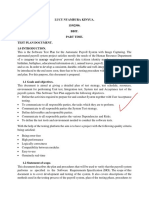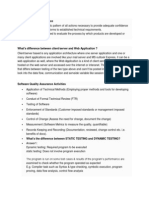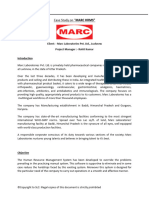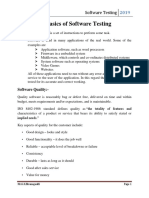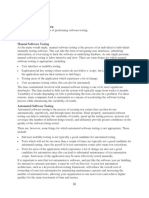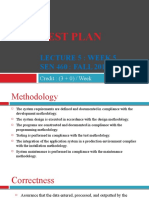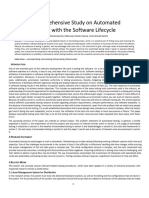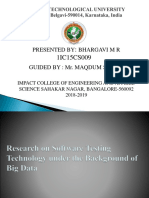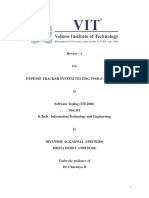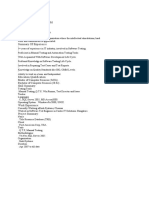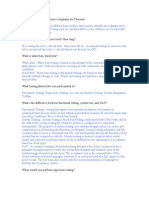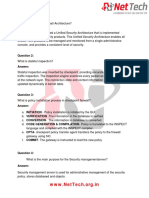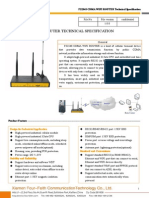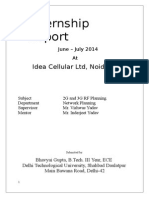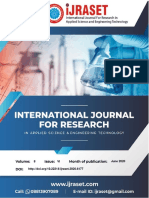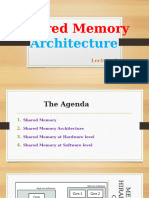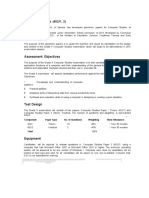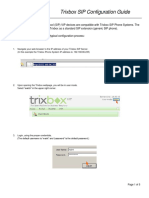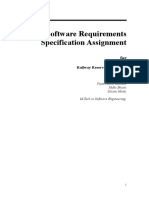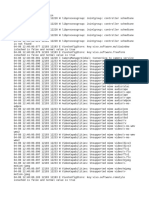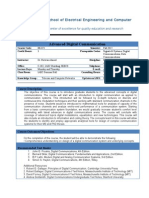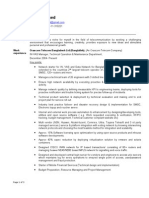To Prepare Software Requirements Specification Document For Employee Management Application
To Prepare Software Requirements Specification Document For Employee Management Application
Uploaded by
UTKARSH ARYACopyright:
Available Formats
To Prepare Software Requirements Specification Document For Employee Management Application
To Prepare Software Requirements Specification Document For Employee Management Application
Uploaded by
UTKARSH ARYAOriginal Description:
Original Title
Copyright
Available Formats
Share this document
Did you find this document useful?
Is this content inappropriate?
Copyright:
Available Formats
To Prepare Software Requirements Specification Document For Employee Management Application
To Prepare Software Requirements Specification Document For Employee Management Application
Uploaded by
UTKARSH ARYACopyright:
Available Formats
EXPERIMENT NO.
02
To prepare Software Requirements Specification document for
Employee management application
INTRODUCTION
The employee record system is very simple and for very beginner mini project. It is
based on the menu-driven program for elementary database management. It employ all
the basic technique of file handling in C. It consists of following features
Writing the data in binary file
Reading the data from binaryfile
Modify the record
Delete the record
This project is a learning milestone for beginners who want to step into the database
management project in C.Employee database management system is consistent of
crucial work-related and important personal information about an employee. In a
nutshell, it is an online inventory of all employees of an organization.Listed below are a
few reasons why employee database management system is important for startups and
small businesses:
Availability
It performs as a readily available source of information between the organization and
the employee. Contact information, salary information, posts, work schedule, education
information etc. is what most database systems consist of.
Efficiency
Employee database management systems are highly efficient. A member of the
organization can easily retrieve information about his/her colleague whenever required,
and that too on short notice. One can avoid making calls to the employee out on
vacation just to retrieve an address to send an important letter.
Accuracy
Since the information is mostly fed in by the employees themselves you can be sure the
Parul Bhartiya Page
information is accurate since it’s straight from the source. Moreover, an employee can
access their information at any time. Therefore, he/she can keep it updated and correct
mistakes, if any.
Updates on time-bound
The information added to the employee database management system can be available
for as long as an employee is working in a firm or if needed, longer than that. Also if at
any point in time, the employee data changes, the employee themselves can make the
alterations. As a result, obsolete data is a rare find on such systems.
Confidentiality
Specific information about the employee can not only be set to be kept private from public viewing
but can also be set to be kept private from anyone.It can insure availability, efficiency, accuracy,
updates on time-bound information, confidentiality etc. You can worry less about managing a bulky
dilapidated file or calling up your employees at inconvenient times or even be stranded without
crucial information with the employee database management system.
Existing system
Existing system is based on standalone systems.
It is developed under Windows 95 that is why it is not compatible with new
operating system.
The human resource administrator falls short of controlling the employee’s
activities in analyzing his/her strengths and weakness.
Disadvantages
Need of extra manual effort.
As current system is stand alone, normal employees cannot track their
employee status.
Proposed system
The proposed system is intranet based system. So employee can also
participate in this system and can track their status.
The proposed system provides detailed general information about the employee
along the educational, skill and project details.
It enhances the human resource management in adding, viewing and updating
employee’s details and generates various reports regarding employee’s skill and
experience.
Parul Bhartiya Page
Advantages
As it is intranet application it can be accessed by multiple users at a time.
Proposed system provides domain login facility so no need to remember user id and
password.
Very fast and accurate.
No need of extra manual effort.
Just need a little knowledge to operate the system.
Doesn’t require any extra hardware device.
SYSTEM REQUIREMENTS
HARDWARE REQUIREMENTS
Processor: Intel core2 duo processor,2.00 GHz
Hard disk drive: 297.2 GB
RAM: 3 GB
SOFTWARE REQUIREMENTS
Software:Turbo C
gcc compiler
SYSTEM DESIGN
Design the physical system.Specify input and output media.Design the database and
specify backup procedures. Design physical information flow through the system and a
physical design Walkthrough.Plan system implementation.Prepare a conversion
schedule and target date.Determine training procedures, courses and timetable.Devise a
test and implementation plan and specify any new hardware/software.Update
benefits,costs,and conversion date and system constraints. Feasibility
study.Requirements engineering.Architectural design module design.
Analysis
Parul Bhartiya Page
Software development life cycle process specifies a method of developing the
software. Eachsoftwaredevelopment projects starts with some needs and ends with
some software that satisfiesthose needs. A software development life cycle
specifies the set of activities that should be performed to go from user needs to
final products.Depending on the nature of project, a suitable model is chosen and the
entire process of softwarerequirement analysis, design, coding, testing and maintenance
is performed accordingly.
Iterative Water Fall Model
An initial investigation culminates in a proposal that determines whether a
system isfeasible or not. It determines its workability, impact on the
organization, ability to meet user needs, and effective user resources. The
objective of feasibility study is not solving the problem but to acquire a sense
of its scope. During the study, the problem definition is crystallized
andaspects of the problem to be included in the system are determined.
Consequently, cost and benefits are estimated with greater accuracy at this
stage. This is a bridge in between the User R e q u i r e m e n t s a n d t h e o u t p u t
t h a t he c a n a v a i l u n d e r a s e t of g i v e n c o n s t r a i n t s , i n p u t s a n d outputs.
Parul Bhartiya Page
Overall design
TESTING
During systems testing, the system is used experimentally to ensure that the
software does notfail. In other words, we can say that it will run according to
its specifications and in the wayusers expect. Special test data are input for
processing, and the results examined. A limitednumber of users may be allowed
to use the system so that analyst can see whether they try to use it in unforeseen
ways.Software modules are tested for their functionality as perthe requirements
identifiedduring therequirements analysis phase.During the testing the program to be
tested is executed with certain test cases and output of thesetest cases is evaluated to
check the correctness of the program. It is the testing that performs first step in
determining the errors in the program.
TEST CASES AND TEST CRITERIA
During Test Cases that are good at revealing the presence of faults is central to
successfultesting. The reason for this is that if there is a fault in the program, the
program can still providethe expected behavior on the certain inputs. Only for the set of
inputs the faults that exercise thefault in the program will the output of the program
devise from the expected behavior. Hence, itis fair to say that testing is as good as its
test case. The number of test cases used to determine errors in the program should be
minimum. There aretwo fundamental goals of a practical testing activity:-
• maximize the number of errors detected and.
• minimize the number of test cases.
As these two goals are contradictory so the problem of selecting test cases is a complex
one. While selecting the test cases the primary objective is to ensure that if there is an
error or fault inthe program, it is exercised by one of its test cases. An ideal test case is
Parul Bhartiya Page
one which succeeds(meaning that there are no errors, revealed in its execution) only it
there are no errors in the program one possible set of ideal test cases is one which
includes all the possible inputs to theprogram. This is often called "exhaustive testing",
however it is impractical and infeasible aseven a small program can have an infinite
input domain. So to avoid this problem we use "test criteria" in selection of the test
cases. There are two aspectsof the test case selection:-
• specifying a criteria for evaluating the test cases.
• generating the set of cases that satisfy a given criteria.
The fully automated process of generating test criteria has not been yet found rather
guidelines are only the automated tool available to us previously. The two fundamental
properties for atesting criterion are:-
• Reliability a criterion is reliable if all the sets that satisfy the criteria detect the same error.
•Validity a criterion is valid if for any error in the program there is some set
satisfyingthe criteria that will reveal the error. The fundamental theorem of testing is
that if a testing criterion is valid and reliable, if a setsatisfying criteria succeeds then the
program contains no errors.
CONCLUSION AND FUTURE ENHANCEMENT
In this report, an information system’s development has been presented. It
wasemphasized on the basic steps, consequently taken during the project’s development
course as a particular attention was turned to the basic operative functionsperformedupon
the data into the database.
FUTURE ENHANCEMENT
As a future work, some additional stuff could be implemented and integrated into
theapplication code making it much more reliable and flexible; especially what concerns
apay-roll module, for instance.
Apparently, the role of such systems is basic and essential within each company
thatwants to keep a really good control and record concerning its personnel
data,functionality and performance on all levels in its structure. Every organization,
innowadays, has the necessity of managing its staff on a really good level as the staff
hasdefinitely the greatest merit of building up a company as such as it is.
The wellmanaged employee means giving the appropriate financial award-ness and all
kind ofbenefits as such as they have been deserved. That’s why the development of
suchsystems is not just a programming business – a lot of people are ordinarily involved
insuch projects and one of the basic requirements is the reliability of the
system,especially what concerns the storage of data and all of the operations that will
beperformed upon it.
Parul Bhartiya Page
EXPERIMENT NO. 03
To prepare UML Use Case Diagram for Library Management System
USE CASE :
Parul Bhartiya Page
EXPERIMENT NO. 04
Modeling UML Class Diagrams for Hospital mgmt application
CLASS DIAGRAM :
Parul Bhartiya Page
PRACTICAL -5:
Modeling UML Sequence Diagrams for Hospital mgmt application.
Parul Bhartiya Page
You might also like
- Employee Management SystemDocument40 pagesEmployee Management SystemMangesh Amant Aure88% (26)
- Test Plan DocumentDocument7 pagesTest Plan DocumentNyambura Kinyua100% (1)
- The Software Development Life CycleDocument7 pagesThe Software Development Life CycleAyush Man BajracharyaNo ratings yet
- SRS For Hotel Management SystemDocument11 pagesSRS For Hotel Management SystemFenilDesani67% (3)
- 5 Overview of Data ConversionDocument24 pages5 Overview of Data ConversionPreeta HaateNo ratings yet
- 1.1 Development of Employee Performance Management - An OverviewDocument57 pages1.1 Development of Employee Performance Management - An OverviewJothi ManiNo ratings yet
- LO1: Prepare For TestDocument5 pagesLO1: Prepare For TestmengistuNo ratings yet
- DBMS Project 14Document18 pagesDBMS Project 14RakibNo ratings yet
- Methods of Software TestingDocument12 pagesMethods of Software TestingSai RaazNo ratings yet
- Project Specifications: Desktop ApplicationDocument13 pagesProject Specifications: Desktop ApplicationamorousrohitNo ratings yet
- Software Testing Interview QuestionsDocument15 pagesSoftware Testing Interview Questionsmadhu_devu9837No ratings yet
- HRMSDocument6 pagesHRMSPallavi PandeyNo ratings yet
- Basics of Software TestingDocument15 pagesBasics of Software TestingPratiksha JadhavNo ratings yet
- Final SEDocument13 pagesFinal SEYashica PaisNo ratings yet
- FinaldssDocument29 pagesFinaldsspancard1098No ratings yet
- Online Mobile Showroom and ServicesDocument45 pagesOnline Mobile Showroom and ServicesPreethu GowdaNo ratings yet
- First Review Part-A Identification and Statement of The ProblemDocument5 pagesFirst Review Part-A Identification and Statement of The ProblemMohamed SaleemNo ratings yet
- Software Testing For Project ReportDocument15 pagesSoftware Testing For Project ReportKamal AcharyaNo ratings yet
- Employee Details in CPPDocument48 pagesEmployee Details in CPPTarun PatelNo ratings yet
- Test Plan: Lecture 5: Week 5 SEN 460: FALL 2016Document23 pagesTest Plan: Lecture 5: Week 5 SEN 460: FALL 2016zombiee hookNo ratings yet
- SEPM ReportDocument65 pagesSEPM ReportAkshay GuptaNo ratings yet
- Synopsis Project Title Job Portal System: College of Management and Computer Sicnece, YavatmalDocument11 pagesSynopsis Project Title Job Portal System: College of Management and Computer Sicnece, YavatmalAshish MOHARENo ratings yet
- Human Resource Management SystemDocument50 pagesHuman Resource Management SystemAravind2600% (1)
- Software Testing An Overview: Srihari TechsoftDocument158 pagesSoftware Testing An Overview: Srihari TechsoftbawyakNo ratings yet
- Testing Resrch PPRDocument9 pagesTesting Resrch PPRadaudd02No ratings yet
- Hospital Management SystemDocument24 pagesHospital Management Systemkaraniphone00No ratings yet
- Project ReportDocument13 pagesProject ReportSreedeviNo ratings yet
- Project: Employee Management SystemDocument31 pagesProject: Employee Management SystemMudassir FazalNo ratings yet
- Softeng Ofse Answers v12Document56 pagesSofteng Ofse Answers v12eresha_tonywijayaNo ratings yet
- SE - Unit IDocument12 pagesSE - Unit I22bcomit034No ratings yet
- Project Report Employee Management SystemDocument23 pagesProject Report Employee Management SystemSonu KumarNo ratings yet
- Mid Term Industrial Training Report: Bug TrackerDocument13 pagesMid Term Industrial Training Report: Bug TrackerDante NeroNo ratings yet
- Software Testing Interview Questions For ExperiencedDocument10 pagesSoftware Testing Interview Questions For Experiencedzynofus technologyNo ratings yet
- STQA Lab 3Document5 pagesSTQA Lab 3Mahede HassanNo ratings yet
- Clinic SystemDocument5 pagesClinic Systemmanali chavan100% (1)
- W11 Tutorial Solutions Chapter 13Document5 pagesW11 Tutorial Solutions Chapter 13mamnunbd100% (4)
- CyberspaceDocument64 pagesCyberspaceAkansha ChopraNo ratings yet
- Softeware Testing TechniquesDocument7 pagesSofteware Testing TechniquesSugandh Gupta100% (1)
- Overview On TestingDocument14 pagesOverview On TestingVikram ReddyNo ratings yet
- SeminorDocument26 pagesSeminorshashank rNo ratings yet
- Dental Clinic Management System JonanDocument86 pagesDental Clinic Management System JonanJoshua CastroNo ratings yet
- Software Testing - ProjectDocument16 pagesSoftware Testing - ProjectDivanshu AggarwalNo ratings yet
- Synopsis: Gandhi Institute of Technologyand Management (Gitam) VisakapatnamDocument8 pagesSynopsis: Gandhi Institute of Technologyand Management (Gitam) Visakapatnamsree anugraphicsNo ratings yet
- 2K20 CO 015 Abhay SharmaDocument10 pages2K20 CO 015 Abhay Sharma2K20CO355 Ranjeet MadhavNo ratings yet
- Mobile:+ 9: K. Raghunath Reddy E-MailDocument4 pagesMobile:+ 9: K. Raghunath Reddy E-MailLokesh S TeliNo ratings yet
- CAPEOFGOODHOPES Body123Document63 pagesCAPEOFGOODHOPES Body123girikiran1977No ratings yet
- 001 - 003 Emplyee Management Information SystemDocument8 pages001 - 003 Emplyee Management Information SystemYUSUF ABDULMALIKNo ratings yet
- Uhard Disk Drive 40 To 80 GB Uárocessor 2.2 GHZ Áentium Á (Or) Á4. U Ram 256Mb Minimum .U 56K Faster Internet ConnectionDocument11 pagesUhard Disk Drive 40 To 80 GB Uárocessor 2.2 GHZ Áentium Á (Or) Á4. U Ram 256Mb Minimum .U 56K Faster Internet ConnectionRajender GovindNo ratings yet
- Software TestingDocument25 pagesSoftware TestingRiya JaiswalNo ratings yet
- CHAPTERDocument42 pagesCHAPTERAnnamalai PNo ratings yet
- IJRPR14696Document11 pagesIJRPR14696utkarshkumarshrivastava4No ratings yet
- Describe Your QA ExperienceDocument10 pagesDescribe Your QA Experience25864No ratings yet
- Jay Prakash, DBMSDocument10 pagesJay Prakash, DBMSAnirudh Adithya B SNo ratings yet
- Software Testing An OverviewDocument158 pagesSoftware Testing An OverviewYashodhan BhattNo ratings yet
- Application Testing Basics:: A Practical Guide To Improving Software QualityDocument21 pagesApplication Testing Basics:: A Practical Guide To Improving Software QualitynithiananthiNo ratings yet
- Index: Page NoDocument51 pagesIndex: Page NoJitendra ChaturvediNo ratings yet
- Online Quiz SystemDocument58 pagesOnline Quiz SystemSarfaraz ali SyedNo ratings yet
- Software Testing Process - What Happens in Software TestingDocument10 pagesSoftware Testing Process - What Happens in Software Testingrony12No ratings yet
- Software Testing Interview Questions You'll Most Likely Be AskedFrom EverandSoftware Testing Interview Questions You'll Most Likely Be AskedNo ratings yet
- 8.checkpoint Firewall Interview QuestionsDocument7 pages8.checkpoint Firewall Interview Questionsnagendra_badam100% (1)
- f3234s Cdma Wifi Router Technical SpecificationDocument4 pagesf3234s Cdma Wifi Router Technical SpecificationCocofourfaithNo ratings yet
- Converting ISO To MDBDocument15 pagesConverting ISO To MDBdorletascribdNo ratings yet
- Adobe Muse Log FileDocument1 pageAdobe Muse Log Fileगोपाल शर्माNo ratings yet
- Sony Dsr-11 Ver-1.1 SMDocument173 pagesSony Dsr-11 Ver-1.1 SMsaul64No ratings yet
- Enterprise Application Platform As A ServiceDocument60 pagesEnterprise Application Platform As A ServiceShreekanthNo ratings yet
- VHDL TutorialDocument37 pagesVHDL TutorialPedro Curahua MejíaNo ratings yet
- Mid Term ReportDocument242 pagesMid Term ReportAshishDevliNo ratings yet
- Model of Grievance Redressal System Using PHP-A Preferred Web TechnologyDocument8 pagesModel of Grievance Redressal System Using PHP-A Preferred Web TechnologyIJRASETPublicationsNo ratings yet
- PLC MCQ Unit5Document4 pagesPLC MCQ Unit5pradnya sadigaleNo ratings yet
- Shared Memory ArchitectureDocument17 pagesShared Memory Architecturemuhammad.786685No ratings yet
- Enterprise Mobility Management With Android For WorkDocument126 pagesEnterprise Mobility Management With Android For WorkRym HAJINNo ratings yet
- Assessment Objectives: Preamble Computer Studies (402/1, 2)Document10 pagesAssessment Objectives: Preamble Computer Studies (402/1, 2)Gift MumbaNo ratings yet
- Trixbox SIP Configuration GuideDocument5 pagesTrixbox SIP Configuration GuideShirley GarayNo ratings yet
- AirLive RS-2500 - Dual WAN Security VPN Gateway - User's ManualDocument7 pagesAirLive RS-2500 - Dual WAN Security VPN Gateway - User's Manualซิสทูยู ออนไลน์No ratings yet
- Bab 10 Image Processing in JavaDocument19 pagesBab 10 Image Processing in JavaFadlan AprialNo ratings yet
- Arduino IdeDocument1 pageArduino IdeCanaza Chique DarwinNo ratings yet
- DW1601 DW1702 DW1703 DW1705 DW1707 and DW1901 Release Notes CS WIN7 Combo 10 14 2014 PDFDocument15 pagesDW1601 DW1702 DW1703 DW1705 DW1707 and DW1901 Release Notes CS WIN7 Combo 10 14 2014 PDFSakazoki TchjiNo ratings yet
- Blackmagic Camera ManualDocument449 pagesBlackmagic Camera ManualAlberto Monti100% (1)
- Railway Reservation System SRSDocument5 pagesRailway Reservation System SRSSatanu MaityNo ratings yet
- 16 022128 04 Troubleshooting PDFDocument38 pages16 022128 04 Troubleshooting PDFNenoNo ratings yet
- LogcatDocument2 pagesLogcatipin kampunganNo ratings yet
- Jetson Agx Xavier Platform Adaptation and Bring-Up GuideDocument41 pagesJetson Agx Xavier Platform Adaptation and Bring-Up GuideafdgtdsghfNo ratings yet
- Chapter 4 - IP AddressDocument20 pagesChapter 4 - IP AddressCha DechavezNo ratings yet
- Course Outline ADCDocument3 pagesCourse Outline ADCmnotcoolNo ratings yet
- 1987 08 UPD77C25 DSP Adv Prod Data SheetDocument36 pages1987 08 UPD77C25 DSP Adv Prod Data SheetAli GachkarNo ratings yet
- Transfer Audio To ScoreDocument2 pagesTransfer Audio To ScoreScribdTranslationsNo ratings yet
- Jamal Ahmed ResumeDocument3 pagesJamal Ahmed ResumejahmedNo ratings yet
- DB2 HADR Performance Tuning: IBM Software GroupDocument28 pagesDB2 HADR Performance Tuning: IBM Software GroupMuthukumar RamamurthyNo ratings yet

